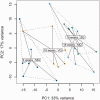Transcriptomic Signatures Mirror the Lack of the Fecundity/Longevity Trade-Off in Ant Queens
- PMID: 26341296
- PMCID: PMC5009957
- DOI: 10.1093/molbev/msv186
Transcriptomic Signatures Mirror the Lack of the Fecundity/Longevity Trade-Off in Ant Queens
Abstract
Life-history theory predicts a trade-off between reproductive investment and self-maintenance. The negative association between fertility and longevity found throughout multicellular organisms supports this prediction. As an important exception, the reproductives of many eusocial insects (ants, bees, and termites) are simultaneously very long-lived and highly fertile. Here, we examine the proximate basis for this exceptional relationship by comparing whole-body transcriptomes of differently aged queens of the ant Cardiocondyla obscurior. We show that the sets of genes differentially expressed with age significantly overlap with age-related expression changes previously found in female Drosophila melanogaster. We identified several developmental processes, such as the generation of neurons, as common signatures of aging. More generally, however, gene expression in ant queens and flies changes with age mainly in opposite directions. In contrast to flies, reproduction-associated genes were upregulated and genes associated with metabolic processes and muscle contraction were downregulated in old relative to young ant queens. Furthermore, we searched for putative C. obscurior longevity candidates associated with the previously reported lifespan-prolonging effect of mating by comparing the transcriptomes of queens that differed in mating and reproductive status. We found 21 genes, including the putative aging candidate NLaz (an insect homolog of APOD), which were consistently more highly expressed in short-lived, unmated queens than in long-lived, mated queens. Our study provides clear evidence that the alternative regulation of conserved molecular pathways that mediate the interplay among mating, egg laying, and aging underlies the lack of the fecundity/longevity trade-off in ant queens.
Keywords: RNA-Seq; aging; fecundity/longevity trade-off; mating; social insect; transcriptome.
© The Author 2015. Published by Oxford University Press on behalf of the Society for Molecular Biology and Evolution. All rights reserved. For permissions, please e-mail: journals.permissions@oup.com.
Figures




Similar articles
-
Sexual cooperation: mating increases longevity in ant queens.Curr Biol. 2005 Feb 8;15(3):267-70. doi: 10.1016/j.cub.2005.01.036. Curr Biol. 2005. PMID: 15694312
-
Mating with an allopatric male triggers immune response and decreases longevity of ant queens.Mol Ecol. 2015 Jul;24(14):3618-27. doi: 10.1111/mec.13267. Epub 2015 Jul 2. Mol Ecol. 2015. PMID: 26059759
-
Transcriptomic response to injury sheds light on the physiological costs of reproduction in ant queens.Mol Ecol. 2016 May;25(9):1972-85. doi: 10.1111/mec.13588. Epub 2016 Mar 28. Mol Ecol. 2016. PMID: 26880273
-
Fitness and aging in Cardiocondyla obscurior ant queens.Curr Opin Insect Sci. 2016 Aug;16:58-63. doi: 10.1016/j.cois.2016.05.010. Epub 2016 May 18. Curr Opin Insect Sci. 2016. PMID: 27720051 Review.
-
The male has done his work - the male may go.Curr Opin Insect Sci. 2016 Aug;16:22-27. doi: 10.1016/j.cois.2016.05.005. Epub 2016 May 13. Curr Opin Insect Sci. 2016. PMID: 27720046 Review.
Cited by
-
Longevity and transposon defense, the case of termite reproductives.Proc Natl Acad Sci U S A. 2018 May 22;115(21):5504-5509. doi: 10.1073/pnas.1804046115. Epub 2018 May 7. Proc Natl Acad Sci U S A. 2018. PMID: 29735660 Free PMC article.
-
Evolution of ageing, costs of reproduction and the fecundity-longevity trade-off in eusocial insects.Proc Biol Sci. 2017 Jul 12;284(1858):20170380. doi: 10.1098/rspb.2017.0380. Proc Biol Sci. 2017. PMID: 28701554 Free PMC article.
-
Gene Coexpression Network Reveals Highly Conserved, Well-Regulated Anti-Ageing Mechanisms in Old Ant Queens.Genome Biol Evol. 2021 Jun 8;13(6):evab093. doi: 10.1093/gbe/evab093. Genome Biol Evol. 2021. PMID: 33944936 Free PMC article.
-
Gene expression clines reveal local adaptation and associated trade-offs at a continental scale.Sci Rep. 2016 Sep 7;6:32975. doi: 10.1038/srep32975. Sci Rep. 2016. PMID: 27599812 Free PMC article.
-
Long-lived Temnothorax ant queens switch from investment in immunity to antioxidant production with age.Sci Rep. 2019 May 13;9(1):7270. doi: 10.1038/s41598-019-43796-1. Sci Rep. 2019. PMID: 31086243 Free PMC article.
References
-
- Andrews S. 2010. FastQC. Available from: http://www.bioinformatics.bbsrc.ac.uk/projects/fastqc/.
-
- Benjamini Y, Hochberg Y. 1995. Controlling the false discovery rate: a practical and powerful approach to multiple testing. J R Stat Soc B Methodol. 57:289–300.
Publication types
MeSH terms
Associated data
- BioProject/MQ18
- BioProject/MQ4
- BioProject/PRJNA284224
- BioProject/PRJNA293450
- BioProject/SQ18
- BioProject/SRR2033894
- BioProject/SRR2033895
- BioProject/SRR2033896
- BioProject/SRR2033897
- BioProject/SRR2033903
- BioProject/SRR2033904
- BioProject/SRR2033905
- BioProject/SRR2177525
- BioProject/SRR2177526
- BioProject/SRR2177527
- BioProject/SRR2177528
- BioProject/SRR2177529
- BioProject/SRR2177530
- BioProject/SRR2177531
- BioProject/SRR2177532
- BioProject/SRR2177533
- BioProject/SRR2177534
- BioProject/SRR2177535
- BioProject/SRR2177536
- BioProject/SRR2177537
- BioProject/SRR2177538
- BioProject/SRR2177539
- BioProject/SRR2177540
- BioProject/SRR2177541
- BioProject/SRR2177542
- BioProject/SRR2177543
- BioProject/SRR2177544
- BioProject/VQ18
Grants and funding
LinkOut - more resources
Full Text Sources
Other Literature Sources
Research Materials
Miscellaneous

